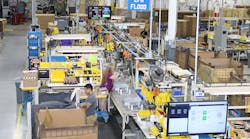The projects will see businesses working collaboratively with other businesses and academic institutions to develop and deploy technologies in areas such as more efficient LEDs, laser diodes, white-light fibre lasers and holographic optics. Other projects will see the integration of new and existing component technologies into working systems.
The total value of the twelve projects is in excess of GBP15.5 million, with the Technology Strategy Board contributing over GBP7m of this figure. The Engineering and Physical Sciences Research Council (ESPRC) is contributing nearly GBP1m to five of the projects.
The TSB's Chief Executive, Iain Gray, said today: "We are committed to stimulating the development and deployment of technologies which, as well as benefiting society, also represent major business opportunities for the UK. Advanced light and laser sources are an area where the UK has an excellent reputation for world-class research activity, a healthy industrial base and the capability to exploit the results globally."
Some of the funded projects are listed below:
Title: LED lighting for the 21st Century [LL21C]
Summary: The LL21C consortium will demonstrate a novel electrically isolated ultra thin GaN LED (EIUT LED) capable of 95% light extraction and designed for general lighting applications.
Partners: PhotonStar LED, University of Cambridge
Title: Low Cost Holographic Optical Elements for Next Generation Lighting Systems: NAHO (Nano Aligned Holographic Optics)
Summary: The NAHO project will develop the technology for production in the UK of edge-lit lighting devices for use in buildings, based on silver halide holographic optical elements (HOEs) illuminated by state-of-the-art LEDs. These will increase efficiency of existing LED flat lighting screens from 45% up to 90% and enable a significant reduction in energy use.
Partners: Harman Technology Ltd, De Montfort University, Concord (Part of Havells-Sylvania)
Title: Enhanced Display Viewability using High Efficiency Advanced LED Backlight Arrays (ENDVIEW)
Summary: This project will deliver enhanced display viewability of dynamic images through the application of high performance LED arrays and novel optics systems.
Partners: GE Aviation Systems, University of Greenwich, University of Abertay Dundee, National Physical Laboratory, Thin Film Solutions Ltd, Raymarine plc, NCR Financial Solutions Group Ltd, Design LED Products Ltd
Title: MENDIPs - Manufacturing emissive nanotechnology devices in polymers
Summary: MENDIPs will create a sustainable controlled pilot manufacturing capability for the production of PLED devices. MENDIPs will also facilitate new auto/architectural/medical device applications as a result of reproducible and repeatable manufacturing processes being created.
Partners: PolyPhotonix, Sanko Gosei Ltd, Centre for Process Innovation Ltd
Title: Willet
Summary: The project goal is a very low cost, low power, high pixel count plastic display for electronic paper applications such as remotely or sporadically updated content - for example point-of-use timetables for transport, conference rooms, point of sale signs, or office notice boards.
Partners: Hewlett Packard Ltd, Epigem Limited
Laser sources and applications
Title: Compact Frequency Converters - From RGB to Emission Effusiometry (CFC-FREE)
Summary: This project seeks to develop a commercially disruptive laser platform based on miniature frequency converters at visible and IR wavelengths. The envisaged light sources will combine superior nonlinear crystals with compact solid-state lasers in an environmentally stable and highly integrable package.
Partners: Stratophase Ltd, University of Southampton
Title: ETOE - II
Summary: ETOE II builds on the success of a previous project (ETOE - Extended Temperature OptoElectronics), which demonstrated the use of new materials (AlInGaAs/InP) in high performance devices operating at high temperatures. ETOE II takes this research forward by addressing devices with higher functionality, eliminating yield hazards in processing complex laser structures based on the new materials and understanding the factors affecting reliability.
Partners: CIP Technologies, University of Surrey, University of Sheffield, Bookham Technology plc, SAFC Hitech Limited, Loughborough Surface Analysis Ltd.
Title: Advanced White Light Fibre Laser and Applications in Medical Imaging (WhiteLase)
Summary: The WhiteLase project addresses the need for high-brightness, efficient visible laser illumination sources by developing advanced white light (supercontinuum) fibre lasers and their applications within biomedical imaging. .
Partners: Fianium Ltd, University of Bath, Edinburgh Instruments Ltd, Genetix Ltd
Title: High Efficiency Laser Processing Systems (HELPS)
Summary: Diode laser technology has the potential to provide significantly more efficient industrial laser sources for materials processing than are currently available, but poor beam quality has limited its market penetration. This project aims to develop fibre coupled diode laser sources with beam qualities good enough to be applicable to broad range of mainstream applications.
Partners: GSI Group Ltd, Cranfield University, Heriot-Watt University, PowerPhotonic Ltd




